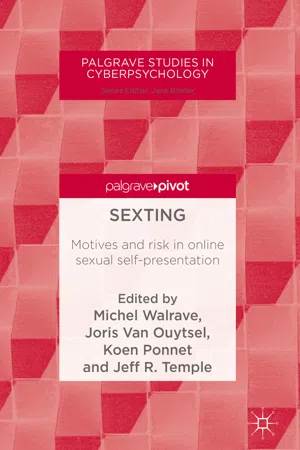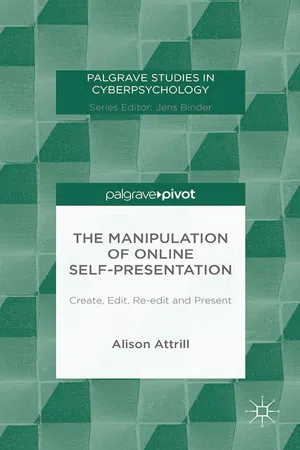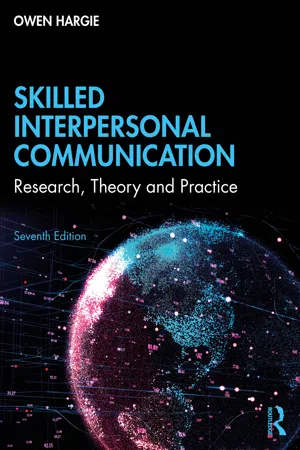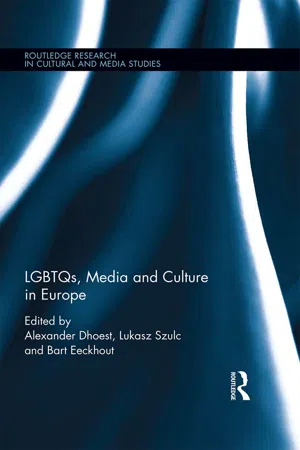Psychology
Self-Disclosure in Virtual Relationships
Self-disclosure in virtual relationships refers to the act of revealing personal information to others in online interactions. It plays a crucial role in building trust and intimacy in virtual relationships. The level of self-disclosure in these relationships can impact the quality and depth of the connection between individuals.
Written by Perlego with AI-assistance
Related key terms
Related key terms
1 of 4
Related key terms
1 of 3
10 Key excerpts on "Self-Disclosure in Virtual Relationships"
- eBook - ePub
Sexting
Motives and risk in online sexual self-presentation
- Michel Walrave, Joris Van Ouytsel, Koen Ponnet, Jeff R. Temple, Michel Walrave, Joris Van Ouytsel, Koen Ponnet, Jeff R. Temple, Michel Walrave, Joris Van Ouytsel, Koen Ponnet, Jeff R. Temple(Authors)
- 2018(Publication Date)
- Palgrave Macmillan(Publisher)
McKenna et al. (2002) state that the establishment of trust and liking between relationship partners is a prerequisite to disclose quite intimate information about oneself. By the same token, the reciprocity of self-disclosure is thus based on the reciprocity of trust (Altman & Taylor, 1973 ; Larzelere & Huston, 1980). With online relationships, however, the formation of reciprocal trust and the disclosure of intimate information (e.g., personal textual and visual information), happens over the width of the Internet. In this popular form of Internet communication, trust is inherent to all components of the user experience throughout the online dating trajectory, such as online messaging, telephone conversations and eventually FtF interactions (Cheshire, 2011). Because apart from being an additional means to find a potential partner and build a romantic relationship, online dating offers the opportunity to build online trust over time through various communication forms (Cheshire, 2011). In order to establish interpersonal trust, the communicators must self-disclose personal information to each other in a reciprocal manner. It comes to no surprise that in online dating and other online environments Internet users expect others to not abuse the self-disclosed personal information. Individuals will not disclose personal information unless they have formed a dyadic boundary ensuring no leakages of the shared information (Derlega & Chaikin, 1977 ; McKenna et al., 2002). Previous research has studied the relationship between trust and self-disclosure in the form of textual (i.e.., text messages, emails, iMessage, …) and visual information (i.e.…, multimedia messages, sexting, …) (e.g., Hasinoff & Shepherd, 2014 ; Peterson-Iyer, 2013 ; Zemmels & Khey, 2015) - eBook - ePub
Information Technology in Organisations and Societies
Multidisciplinary Perspectives from AI to Technostress
- Zach W. Y. Lee, Tommy K. H. Chan, Christy M. K. Cheung, Zach W. Y. Lee, Tommy K. H. Chan, Christy M. K. Cheung, Zach W. Y. Lee, Tommy K. H. Chan, Christy M. K. Cheung(Authors)
- 2021(Publication Date)
- Emerald Publishing Limited(Publisher)
Nguyen et al. (2012 ) suggested that self-disclosure was not consistently found to be greater in the online contexts. The tendency for one to engage in online self-disclosure is potentially altered by contextual factors such as the relationship between the communicators, the specific mode of communication, and the interaction’s context.The assumption that self-disclosure is enhanced in an online context is often explained with a number of computer-mediated-communication theories, models, and hypotheses (Walther, 2011 ), such as social presence theory (Short, Williams, & Christie, 1976 ), the lack of social context cues hypothesis (Sproull & Kiesler, 1986 ), information richness theory (Daft & Lengel, 1983 ), the social identity model of deindividuation (SIDE model), with the most prominent one being the hyperpersonal communication model (Walther, 1996 ). According to the hyperpersonal communication model (Walther, 1996 ), online interaction can be hyperpersonal because it offers a sender various communicative advantages than face-to-face communication. Specifically, a message sender can strategically develop and adjust the content to be presented, which gives him/her the opportunity to be engaged in a selective and optimised presentation of oneself to others without the need to look into others’ eyes and fears of others’ evaluation. As a result, it renders the feeling of online disinhibition – a psychological state when individuals become loosen up and feel less restrained to perform certain behaviours in the online environment (Cheung, Wong, & Chan, 2020 ; Suler, 2004 ).Performing self-disclosure has been linked to achieving interpersonal advantages and maintaining one’s mental health state when under stress (Zhang, 2017 ). The research on offline self-disclosure has long recognised the importance and benefits of expressing oneself (Jourard, 1964 ; Moriwaki, 1973 ; Toukmanian & Brouwers, 1998 ). Jourard (1959 ) contended that the ability to disclose is one of the prerequisites for a healthy personality. Stiles, Shuster, and Harrigan (1992 ) suggested that people need a higher disclosure level when under distress. As Sloan (2010 - eBook - ePub
The Manipulation of Online Self-Presentation
Create, Edit, Re-edit and Present
- A. Attrill(Author)
- 2015(Publication Date)
- Palgrave Pivot(Publisher)
There is a level and type of self-disclosure here that is not reliant on knowing each others’ real self-identities. Some might find this type of interaction a little strange, but this is becoming a more acceptable way of communicating with others for many people, and by doing so, it brings with it a whole area of self-representation and self-disclosure online that simply cannot be equalled offline. Indeed, much early work that compared online to offline self-disclosures supported that people were often likely to share more self-information, and more intimate and personal information online with people who are completely unknown to one another in the offline world (e.g., Christofides, Muise & Desmarais, 2009; Gibbs, Ellison & Heino, 2006; Bonebrake, 2002; Cooper & Sportolari, 1997). Sharing the self online in this way was initially considered to result from a sense of anonymity online affording individuals the ability to explore their self-identity in a way that avoided the social humiliation or social rejection that they might have experienced in an offline encounter (McKenna & Bargh, 1998). To further consider whether people do expose themselves so willingly online, this chapter explores some of the research associated with how people present themselves online through their online self-disclosures. Throughout this text, consideration has been given to whether people are more likely to present their actual self online, or a carefully crafted version of self that represents an ideal who they would like to be. In terms of self-disclosure, some evidence suggests that people are more likely to reveal their real or actual self to others as a relationship develops (e.g., Chelune, 1979; Greene, Derlega & Mathews, 2006). This gradual revelation of the true self is the premise of one of the founding theories of offline self-disclosure, the Social Penetration Theory (SPT) (Altman & Taylor, 1973) - Edward M. Waring(Author)
- 2013(Publication Date)
- Routledge(Publisher)
In a series of studies we had developed an operational definition of intimacy as “a multifaceted interpersonal dimension which describes the quality of a marital relationship at a point in time” (Waring et al., 1981b). Intimacy is a composite of 1) affection—the degree to which feelings of emotional closeness are expressed by the couple; 2) expressiveness—the degree to which thoughts, beliefs, attitudes, and feelings are communicated within the marriage; 3) compatibility—the degree to which the couple is able to work and play together comfortably; 4) cohesion— a commitment to the marriage; 5) sexuality—the degree to which sexual needs are communicated and fulfilled; 6) conflict resolution—the ease with which differences of opinion are resolved; 7) autonomy—the couple's degree of positive connectedness to family and friends; and 8) identity—the couple's level of self-confidence and self-esteem. Other operational definitions of intimacy are also available (Schaefer & Olson, 1981).WHAT IS SELF-DISCLOSURE?
Jourard and Sasoko (1958) were the first to systematically study the phenomenon of self-disclosure which they believed was a “symptom of health” and a “means to interpersonal effectiveness.” Chelune (1978) defines self-disclosure as “a process of making ourselves known to other persons by verbally revealing personal information.” Self-disclosure can be classified as: 1) expression of emotion; 2) expression of need; 3) expression of thought, attitudes, beliefs, and fantasy; and 4) self-awareness. The latter two are defined here as “cognitive self-disclosure.”Now let us return to our operational definition of intimacy. Jourard and Sasoko (1958) demonstrated that the most consistent personal disclosures occurred in the marital relationship. Waterman (1980) reviewed studies which demonstrate a positive relationship between amount of self-disclosure and marital adjustment. Several authors have suggested that self-disclosure may be an important determinant of a couple's level of intimacy (Schaefer & Olson, 1981; Waring & Russell, 1980a). Waring and Chelune (1983) empirically demonstrated that self-disclosure is a significant determinant of the rated levels of expressiveness, compatibility, identity, and intimacy behavior, four of the eight factors which define level of intimacy. Thus self-disclosure determines 50% of the variance of rated level of intimacy in married couples.Cognitive Self-Disclosure
Cognitive self-disclosure refers to the process of making ourselves known to others by verbally revealing personal thoughts, beliefs, attitudes, and assumptions, as well as developing self-awareness. Waring et al. (1980) found that cognitive self-disclosure was thought by couples in the general population to be the primary determinant of intimacy. This finding supported an earlier observation by Grinker (1967) that cognitive knowledge or “knowing” one's partner may be a primary determinant of a couple's level of intimacy. Is there evidence to support this relationship? Levinger and Senn (1967) demonstrated that there is more disclosure of unpleasant feelings, affective self-disclosure of a negative quality, in unsatisfied couples—disclosure of negative feelings produces distance and is characteristic of disturbed families. Murstein (1974) suggests that a major problem in marriage is a failure to disclose attitudes, values, and beliefs during courtship, which results in a lack of cognitive information that could prevent choices in which conflicting value systems prevent closeness.- eBook - ePub
- Sarah Knox, Clara Hill, Sarah Knox, Clara Hill(Authors)
- 2018(Publication Date)
- Routledge(Publisher)
Although it may seem to those who are not digital natives that disclosure via Facebook or other CMC cannot be as intimate or meaningful as face-to-face communication, past work has suggested that there may be some advantages to these newer forms of communication. As many theorists and researchers (e.g. Kim & Dindia, 2011; McKenna & Bargh, 2000) have noted, the very distance, disembodiment, lack of verbal cues, and at times, anonymity, afforded by CMC can, for some people at least some of the time, provide a measure of safety that may facilitate the frequency, breadth, and depth of interpersonal disclosures. For some individuals, then, the absence of interpersonal proximity across forms of CMC facilitates disclosure (i.e. literal “up closeness” increases shame and inhibits disclosure); for some individuals too, an additional advantage afforded by online platforms is immediate access to targets of disclosure.Indeed, until recently, most theory and research had indicated that online disclosure was more personal in many respects than offline disclosure. Online communication was often considered “hyperpersonal” (Walther, 1996, 2007), a condition thought to result from the anonymity, comfort, and selective, mostly positive, content of online disclosures. By contrast, more recent meta-analyses (e.g. Kim & Dindia, 2011; Nguyen, Bin, & Campbell, 2012) have found no consistent pattern of results: “contrary to expectations, disclosure was not consistently found to be greater in online [as compared to offline] contexts” (Nguyen et al., 2012, p. 103). However, the offline disclosure measured in past research did not include the specific offline context of psychotherapy, and indeed no prior research has investigated differences in self-disclosure between a specific online platform (i.e. Facebook) and a specific offline context (i.e. psychotherapy).While both platforms are popular and offer effective ways of disclosing aspects of oneself to others, there are limitations and problems inherent to both. The Pew Research Center (2014) report on “new facts about Facebook” began with the most common Facebook user dislike: “people sharing TMI about themselves.” As for disclosures in psychotherapy, while clients tend to find the psychotherapeutic setting a safe place to disclose, multiple research reports have indicated that many clients fail to disclose salient clinical information (Farber, 2006; Hill et al., 1993) and/or minimize, distort, or even lie about their histories or current experience (Blanchard & Farber, 2015; Farber & Blanchard, 2014). No means of disclosure – whether through Facebook or psychotherapy or face-to-face communication – entirely attenuates human tendencies to want to avoid shame and create positive impressions (e.g. Goffman, 1956). - eBook - ePub
Media and Public Shaming
Drawing the Boundaries of Disclosure
- Julian Petley(Author)
- 2013(Publication Date)
- I.B. Tauris(Publisher)
6Cultural and Gender Differences in Self-Disclosure on Social Networking Sites
Jingwei Wu and Heng Lu1Introduction
Self-disclosure is defined as what individuals reveal about themselves to others, including thoughts, feelings, and experiences. Computer-mediated communication (CMC) has changed the communication environment and the way people interact with each other. Unlike face-to-face (FtF) communication, CMC can lower barriers of interaction and encourage more self-disclosure (Joinson, 2001; Tidwell and Walther, 2002). The users of particular social web applications tend to reveal many personal details.The prevalence of Social Network Sites (SNSs) has focused considerable public attention on the threat to privacy brought about by self-disclosure on SNSs. SNS users desire to present themselves, express feelings, and develop relationships (Derlega and Grzelak, 1979), as well as to erase the feeling of loneliness (Morahan-Martin and Schumacher, 2003). However, the protection of privacy is somewhat overlooked. In July 2010, privacy concerns swirled around Facebook after an individual compiled and released personal data on more than 100 million Facebook users, about a fifth of the site’s membership (Figueroa, 2010). Although many SNSs have elaborated their systems of privacy settings, peers and even strangers still can access certain personal information. Media coverage also increases concerns about the privacy and information security of SNS users.The privacy settings of SNS users have captured the attention of researchers. Gender and cultural differences in self-disclosure are two research foci central to the tradition of self-disclosure studies. A meta-analysis of studies of the gender differences in self-disclosure in offline settings has found that women disclose more than men (Dindia and Allen, 1992). However, the results of existing studies of online self-disclosure are unexpectedly inconsistent. These find significant differences in self-disclosure in SNSs (Dominick, 1999; Tufekci, 2008) and evidence that women have more online privacy settings than men (Lewis et al., 2008). Nonetheless, other studies indicate that there are no gender differences in levels of self-disclosure in online forums (Barak and Gluck-Ofri, 2007) or online chatting (Cho, 2007). - eBook - ePub
- Gráinne Kirwan, Irene Connolly, Hannah Barton, Marion Palmer(Authors)
- 2024(Publication Date)
- Routledge(Publisher)
Social penetration theory posits that relationships move from less intimate to more intimate involvement over time, with people disclosing deeper information about themselves as the relationship progresses (Altman & Taylor, 1973). In the initial stages of a relationship people act with caution, disclosing less intimate information, but gradually when they see signs of reciprocity, they begin to open up and share other aspects of themselves. In online dating this dynamic can shift, as dating profiles reveal a lot of the information that people would typically use for getting to know someone, removing the opportunity to gradually learn about each other. Additionally, because of the anonymity of online dating, the online environment can feel like a safer space in which to reveal core aspects of the self, so communications can become intimate very quickly. On the other hand, the information in a dating profile can also halt communication before it has even begun, as decisions about attraction are often made before any interaction has taken place (LeFebvre, 2018). Antheunis et al. (2020) found that the hyperpersonal effect persisted in an online dating context when people moved from text-based CMC to meeting in person. Social attraction was higher for people who communicated via text than for those who communicated through video chat before meeting face to face, and that social attraction remained higher upon meeting for those in the texting condition, particularly for women. Romantic attraction, however, declined for both text and video groups on meeting in person - eBook - ePub
Skilled Interpersonal Communication
Research, Theory and Practice
- Owen Hargie(Author)
- 2021(Publication Date)
- Routledge(Publisher)
In a mutually advantageous exchange, each person provides resources that meet the needs and wants of the other at an equal or lower cost to self than the value of the resources received from them. This ensures that the relationship will be maintained. Self-disclosure can be considered as one of the social exchange benefits of a relationship. In terms of the exchange of disclosures, we are also concerned with risk, and so need to be convinced of the bona fides of the interlocutor to repay our initial interpersonal investment. In this way, ‘SET clearly argues that when uncertainty or ambiguity in a social exchange is reduced, the benefits from that exchange are perceived as more likely’ (Proudfoot et al., 2018, p. 23). Furthermore ‘SET is also premised on reciprocity. A person is more likely to disclose information if he or she expects that the other party will reciprocate by sharing similar information about themselves’ (Liu et al., 2016, p. 55). So, in terms of self-disclosure, SET contends that when A discloses to B this is a form of investment in the relationship and, for the relationship to continue in a balanced fashion, there is then an obligation placed on B to reciprocate with a disclosure, to balance the exchange account. As noted by Harper and Harper (2006, p. 251), ‘one feature of self-disclosure is its reciprocity; meaning that a person’s disclosure increases the likelihood that the other party will also disclose’. Indeed, there is evidence that this norm of reciprocity holds even when the recipient of disclosure is a computer pre-programmed to respond in specific ways (Moon, 2000). Social penetration theory (Altman and Taylor, 1973 ; Taylor and Altman, 1987) postulates that relationships progress through the following stages: Orientation. When people meet for the first-time, shallow information about self is disclosed more readily than intimate details. For the relationship to develop, initial disclosures must be reciprocal. Exploratory affective exchange - eBook - ePub
- Alexander Dhoest, Lukasz Szulc, Bart Eeckhout(Authors)
- 2016(Publication Date)
- Routledge(Publisher)
Sharing information with others online and possible unsafe sexual practices that follow online activities are also closely connected with the understanding of intimacy. Some internet researchers see intimacy as inherently virtual (McGlotten, 2013), but when asked to describe intimacy online only a minority of my interviewees saw online communication as intimate in nature (6 out of 25). For them the modalities of physical proximity, from sexual encounters to ‘shared silence’ between partners, are at the core of intimate relationships. Nevertheless, the predominant view of intimacy as the disclosure of thoughts and secrets considers this to be something extremely personal. The definition of intimate practices to which gay men in this research refer is what Orthon-Johnson and Prior call ‘disclosing intimacy’, conceived as a ‘dialectic of mutual self-disclosure, a sharing of inner thoughts and feelings’ (2013, p. 18). Embodiment in connection with intimacy and expression of this relation are seen as ‘the intimacy of the self rather than the body, although it might be enhanced by bodily intimacy’ which leads to ‘the pleasure of co-presence’ in a virtual space (ibid., p. 18).How do internet users structure intimacy online? For Reid (1999) the context of the internet and the need for communication encourage users to be intimate or to simulate intimacy. The possibility of simulated intimacy, as well as the disclosure of identity online, enhances the possibility of online communication being based on wrong assumptions about the other. Thus one’s HIV status and the interplay of intimacy and identity disclosure online could be a risk factor for HIV transmission. Indeed Davis suggests that internet-mediated sexual practices based on intimacy are structured around anonymity online, adding that ‘anonymous intimacy’ increases the possibility of transmission of HIV and other STDs in offline unsafe sexual behaviour (2008, pp. 53–54). These conclusions are clearly important for contemporary gay identities and body politics in the Serbian HIV/AIDS discourse, as well as for the use of online communication in this context. - eBook - ePub
- John Weckert(Author)
- 2017(Publication Date)
- Routledge(Publisher)
This isn’t a problem, however, for Net “friendship” and interaction as such. It is a problem, or set of problems, facing certain sorts of individuals. In the normal run of cases of Net “friendships”, it should be admitted, there is, in the ways outlined above, a lack of relevant disclosure to the other, and so a lack of some of the importantly relevant interaction and self-development that features in friendship. But this thesis depends on facts about our psychologies. It is not a conceptual claim about a virtual world dominated by voluntary self-presentation and interactions. Indeed, it might be argued we could imagine certain individuals who do not suffer the sorts of pitfalls mentioned earlier of diminishing, denying, and omitting relevant character cues given by non-voluntary behaviour in the non-virtual case. Such individuals would seek to compensate and overcome these problems. They would, e.g., voluntarily disclose their failings, and what they feel uncomfortable about, and they would be careful to not block or filter, say, their spontaneous thoughts and reactions to others. They would diligently and carefully report on those aspects of character which ordinarily, as they well know, play a crucial role in the interactive process of self-creation in friendship. Of course not every tiny detail is worthy of disclosure, but only those salient aspects of physical appearance, manner, habit, belief, intention, interest and the rest which, but for the Net, might well be manifestly available to the other, and crucially relevant to the other’s interpretation of character as it effects the shaping of the self in friendship. So let us imagine two people – the diligent disclosers – who with a meticulous and painstaking effort attempt to overcome the internet barriers to friendship in the way described
Index pages curate the most relevant extracts from our library of academic textbooks. They’ve been created using an in-house natural language model (NLM), each adding context and meaning to key research topics.
Explore more topic indexes
Explore more topic indexes
1 of 6
Explore more topic indexes
1 of 4









